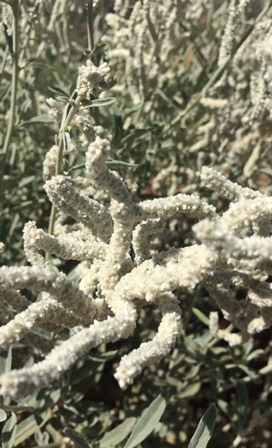At this time of year, old Christmas Carols and songs are often heard through sound systems of businesses, shopping centres, radio stations, churches, parks, gardens and family homes (admittedly some of these areas may not reverberate with musical Christmas cheer!) But Land for Wildlife Central Australia request that you be mindful of what song you sing along with and don’t go ‘Wishing for a White Christmas’ (original score ‘I’m dreaming of a white Christmas’ written by Irving Berlin in 1940 & first sung by Bing Crosby on Christmas Day 1942…sorry for just giving you an earworm for Christmas!!) So having sent out the request, I am actually using this song to segway into highlighting an important environmental issue for our Land … & Garden for Wildlife members information.
Recently a pretty flowering plant caught my attention and prompted me to whistle that very tune and consider what an appropriate time of year that it should be flowering. However!!! Upon identification I was disappointed to discover that the attractive snowy-looking flowers belonged to an introduced plant species called the Kapok Bush (Aerva javanica). The plant is native to northern Africa and south-east and southern Asia. It was originally used in Australia for soil stabilisation and revegetation of disturbed lands e.g. mine sites, as well as a garden ornamental. The plant has, unfortunately, established itself as a weed in areas of the NT, including the Alice region, WA and Qld and is considered a pest species. Typical of a pest species, the seeds disperse easily and being light they utelise wind, water, animal fur and feces, human clothing, vehicles and machinery. In Alice the plant may be found in gardens, roadsides, urban development areas and pastoral lands.

The offending eye-catching Kapok Bush sighted at the Sewerage Treatment Plant in Alice Springs recentlyRemoving without spreading seed
The Kapok Bush has a woody taproot and may prove a little difficult to remove by hand. However, removal is nothing that a good hoe or shovel, and a bit of grunt, can’t handle. What is most important when removing or ridding the area of the plant is to not disperse any seeds during the removal process. This can easily be avoided by placing a plastic bag over the plant and tying it tightly at the base. If you are using a herbicide, make sure you capture the seeds as the plant dies by again placing a bag over the bush and removing the plant with bag attached once it has died. Make sure you destroy the plant and seeds appropriately by not placing them in a household compost bin or loose in your garbage bin where the plant/seeds will be taken to the tip only to disperse there.